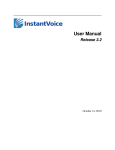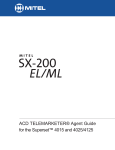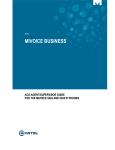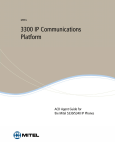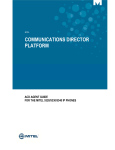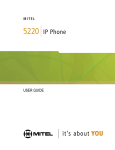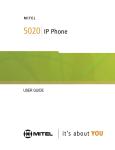Download ACD Agent/Supervisor User Guide - 4025/4125
Transcript
ACD 2000 Agent/Supervisor/Senior Supervisor Guide for the Superset™ 4025/4125 DUE TO THE DYNAMIC NATURE OF THE PRODUCT DESIGN, THE INFORMATION CONTAINED IN THIS DOCUMENT IS SUBJECT TO CHANGE WITHOUT NOTICE. MITEL CORPORATION, ITS AFFILIATES, AND/OR ITS SUBSIDIARIES ASSUME NO RESPONSIBILITY FOR ERRORS AND OMISSIONS CONTAINED IN THIS INFORMATION. ™ Trademark of Mitel Networks Corporation. © Copyright 2001, Mitel Networks Corporation. 1\\bYWXdcbUcUbfUT Contents General Information About this Guide 5 What is Automatic Call Distribution (ACD)? 6 About Your SUPERSET 4025/4125 7 Personal Keys Line Select Keys/Line Appearances Line Status Indicators Feature Keys Main Display The SuperKey and Softkeys Function Keys Feature Access Codes Features Not Available 7 7 8 8 8 9 9 10 10 ACD 2000 Agent Features and Capabilities What are Agent Groups? Logging In Displaying Agent Log-In Information Logging Out Answering Calls Using the Auto Answer Feature Using a Headset Using and Canceling the Work Timer Taking a Break from Calls (Make Busy Feature) Getting Help Queue Threshold Alert Queue Status 3 11 12 14 16 17 18 19 20 23 24 25 27 28 ACD 2000 Supervisor Features and Capabilities What is the Supervisory Position? Queue Threshold Alert / Queue Status Silent Agent and Group Monitoring Conferencing Responding to Help System Reporting Capabilities Personal Directory 29 30 31 32 35 36 38 40 4 General Information About this Guide This guide describes operation of the Automatic Call Distribution (ACD) 2000 Feature Package on a SUPERSET 4025/4125 telephone set. For further information on ACD, see ”What is Automatic Call Distribution“. The displays shown throughout this guide are intended to be representative only. Certain displays on the sets may differ from those shown, usually based on what features or Class Of Service has been programmed into individual sets. For operation of other features associated with a SUPERSET 4025/4125 set (some of which will work in conjunction with ACD), refer to the set guide. IMPORTANT NOTE FOR HEADSET USERS: MITEL’s Headset with Feature Control Switch (PN 9132-800-500-NA) must be installed in the dedicated headset jack (the jack nearest the front of the set). Installation will disable your handset microphone. Disconnecting the headset at the jack or at the quick-disconnect plug restores handset operation. 5 What is Automatic Call Distribution (ACD)? The Automatic Call Distribution (ACD) 2000 Feature Package is offered by the SX-2000 INTEGRATED COMMUNICATIONS System. ACD is a method of switching large volumes of similar calls directly to a selected group of extensions (Agents). Up to 350 such Agents can be supported. All calls are distributed equally among the Agents. The calls are all of a similar nature, and the Agents are trained/equipped to provide the particular information or service the caller is requesting. Typical examples of ACD applications include: • airline reservation offices • telephone order desks for department stores • customer service departments of telephone or cable T.V. companies When there are more incoming calls than available Agents, the calls may be routed to recordings. The recordings may advise the callers that all Agents are busy, and that an Agent will answer as soon as possible. Various recordings may be provided to inform the caller as to call progress if an Agent is not accessed immediately, or to advise the caller of information the Agent will require when connection is established. The SX-2000 system also directs calls to the Agent so that all Agents are given an equal workload. A Supervisor usually oversees the operation, monitors the activity of the Agents, and handles unusual situations which may arise. 6 About Your SUPERSET 4025/4125 Telephone Personal Keys At the bottom of your SUPERSET 4025/4125 there are two rows of Personal Keys. The first Personal Key (the lower right-hand key) is your Prime Line, the telephone line that you will usually use. Your extension number is the number of your Prime Line. Other Personal Keys can be programmed as Speed Call Keys, Line Select Keys or Feature Keys. Line Select Keys/Line Appearances Your SUPERSET 4025/4125 telephone can accommodate up to 14 lines, including your Prime Line (your listed number). Your Prime Line always appears at the lower right-hand Personal Key. A Personal Key can be programmed as a Line Select Key. Line appearances on your set may be used as separate telephone lines or shared with other extension users. However, you cannot intrude on any conversation that they are having without their permission, and they cannot intrude on any conversation you are having without your permission. Contact your System Administrator to have Line Select Keys programmed for your set. 7 Line Status Indicators The Line Status indicators are located on the outside edge of each Personal Key. These LED indicators show you the status of the lines which you have programmed on your set. If a Personal Key has been programmed as a Feature Key, the status indicator for that key will turn on when the feature is activated, and turn off when the feature is disabled. When a line is... the status indicator is... Idle Busy Ringing On Hold at your set On Hold at another set off solid on flashing slowly flashing rapidly flashing in a slow on, fast off cycle on your set’s Line appearance Feature Keys A Personal Key can also be programmed as a Feature Key by your System Administrator for quick access to an often-used feature. When that key is pressed to turn on the feature, the status indicator for that key will turn on. Contact your System Administrator to have Feature Keys programmed for your set. Main Display The main display, located at the top of your SUPERSET 4025/4125, shows the SuperKey instructions and Softkey labels. The Redial number, the name of the feature currently active, messaging information, and telephone system error messages can also be shown. When your telephone is idle, the current date and time of day are displayed continuously. But as soon as you make or receive a call, the display shows information about that call, such as which line or trunk is being used, and the duration of the call. This is useful when you are charging the cost of a call to a customer or an account number. 8 The SuperKey and Softkeys Softkeys are the three keys located directly beneath the main display. You can use the Softkeys to select the related prompt in the main display. These keys are unlabeled because their functions can change as the prompts in the main display change. The SuperKey Function Key allows you to access the many features available through the Softkeys. When you press the SuperKey the main display changes. In particular, Softkey prompts on the screen change. Prompts appear only when they can be used and if they are available to you. To exit a SuperKey session, press the SuperKey once more. Function Keys The Function Keys are located just below the main display. A number of the SUPERSET 4025/4125 features are accessed by using the Function Keys on your telephone. 1. Message Key: for sending and responding to messages. 2. Hold Key (red key): for placing calls on hold. 3. SuperKey (blue key): for programming Personal Keys as Speed Call Keys, accessing most set features, and displaying set information. 4. Trans/Conf Key: for transferring calls and setting up conference calls. 5. Speaker Key: for answering and hanging up a call during hands free mode. 6. Microphone Key: for turning the microphone on or off (a privacy feature) during a handsfree call. 7. Redial Key: for redialling the last dialed number. 8. Î and Ï Keys: for changing the volume of the handset receiver, the volume and pitch of the ringer, and adjusting the contrast of the main display. 9. Cancel Key: for canceling call features in progress. 9 Feature Access Codes Many features can be activated or disabled by Feature Access codes when no Feature Keys are programmed for this purpose. Contact your System Administrator for these and other Feature Access codes available on your telephone system, or to have these features programmed into your set’s Softkeys. Record your Feature Access codes in the Personal Directory table at the end of this guide. Features Not Available There may be procedures in this guide which you cannot perform on your telephone set, and your display may not appear exactly as in the illustrations in this guide. You may have additional functionality not described in this guide, or some features described here may not be available to you. The reason for this is that your company has specially selected your features and calling privileges. See your System Administrator if you have any questions. 10 ACD 2000 AGENT FEATURES AND CAPABILITIES 11 What are Agent Groups? ACDAgents are normally grouped together to handle incoming telephone calls that are associated with particular functions or departments in an organization; for example, Sales or Engineering. Callers are then directed to the Group that best serves their needs. The formation of ACD Agent Groups with two or more Agents in each Group allows calls to be handled on a Group basis rather than on an individual basis. An Agent can have multiple Agent ID’s, but Agents can only have one Agent ID per group, and can only log in one Agent ID per telephone. Agent Groups are assigned a unique 3-digit reporting number as well as an Agent Group directory number. You will use both of these numbers as discussed throughout this guide. Agent Groups can be programmed to overflow between each other. This means that if activated, calls that are directed to one Agent Group can be programmed to overflow to other Agent Groups if the first Group was unavailable due to being in an overload condition. This overflow capability allows ACD calls to be handled, even though an Agent Group has been set in a Do Not Disturb mode. You can have your set programmed to receive additional information concerning Group activity. This information is called Queue Threshold Alert and Queue Status. The following Agent functionality is described in this section: Logging In describes the procedure for logging in to a telephone set programmed for Automatic Call Distribution (ACD). Displaying Agent Log-In Information describes the procedure for displaying your Agent I.D. number for verification after logging in. Logging Out describes the procedure for logging out from a telephone set programmed for ACD. Answering Calls describes the procedure for answering ACD calls. Using the Auto Answer Feature describes the feature which allows you to answer calls automatically after one short ring. Using a Headset describes the procedure for installing and programming a headset for hands-free call answering. Using and Canceling the Work Timer describes the purpose of the Work Timer and the procedure for answering calls without waiting for the Timer to expire. 12 Taking a Break from Calls (Make Busy Feature) describes the procedure for placing your set in a pause mode when you need to be away from your set for brief periods of time, without the need to log out and subsequently log in again. Getting Help describes the procedure for requesting assistance from your Supervisor during a call. The procedure for terminating a Help request is also described. Queue Threshold Alert / Queue Status describes alert indicators and means of accessing queue information for regarding the status of the ACD Group (Queue) into which you have logged. 13 Logging In Automatic Call Distribution (ACD) 2000 calls are directed to Logged In Agents only. ACD calls are not directed to a telephone set where there is no Agent Logged In. You can log in by following the procedure described below. An important concept in the ACD 2000 system for you to be aware of is agent mobility. Since you as an Agent are assigned a 1- to 7-digit Identification (I.D.) number to log in with, you can be called by this I.D. number, as well as by the telephone set extension number where you are working. This means that you can be called by your I.D. number regardless of where you may be located. For this reason it is also a good idea for your Agent I.D. number to be included in your company’s telephone directory. You can log in to only one Group at any one time. Check with your manager if you do not know the ACD Log-In access code or do not have an I.D. number. The Agent I.D. number is unique to each Agent, and allows the system to distribute ACD calls to Logged In Agents. An Agent can stay logged in indefinitely on the same telephone set. You can also log in by using a special Feature Access code not explained in this guide. NOTE: If the I.D. is invalid, the display shows an INVALID error message and the Log-In procedure is terminated. If the I.D. is in use by another Agent, the display shows a USED BY error message and your Log-In attempt is terminated. If an Agent Log-In code is dialed, but no I.D. is entered within 60 seconds, the Log-In procedure is not activated and your set is treated as a Logged Out set. After you have logged in, you can display your Log-In information. Refer to the section ”Displaying Agent Log-In Information“ for further details. 14 When You Are Ready to Log In To log in, perform the following tasks: 1. Press the SuperKey Function Key. The prompt AGENT LOGIN? Appears. 2. Press the Yes Softkey. 3. Enter your Agent I.D. code on the keypad. After entering your I.D. code, your display shows the number you enter along with a Ì Softkey to correct any digits you entered incorrectly. 4. Press the Enter Softkey. You are now logged in. The display momentarily shows the name of the Agent logging in (if programmed) and the Agent’s I.D. number. After a few seconds, the display returns to idle, with any programmed Softkey features appearing on the display. 15 Displaying Agent Log-In Information It is possible to display and verify Log-In information when you are logged in to a set. The information displayed is the Agent I.D. number logged in to that set. This is accomplished by the following tasks: 1. Press the SuperKey Function Key. 2. Press the No Softkey until PERSONAL KEYS appears on the display. 3. Press the Yes Softkey. The Agent Identification (I.D.) number currently logged in will be displayed for 3 seconds . 4. The prompt SELECT A KEY appears. You may select another Line Select Key for similar information if the set has more than one line appearance. If you press your Prime Line Key, your display shows your Agent I.D. number and your name (if programmed). 4. To exit, press the Cancel Function Key. 16 Logging Out Logging out returns the set to Make Busy and it no longer receives Automatic Call Distribution (ACD) calls, since ACD calls are directed to Logged In telephone sets only. Your set operates normally for non-ACD use when logged out. Logging Out can be activated during a call in progress, and takes effect only when you terminate (hang up) the call. This allows you to activate this feature before your set can ring again for another call. When You Are Ready to Log Out To log out, perform the following tasks: 1. Press the SuperKey Function Key 2. Press the No Softkey to scroll until AGENT LOG OUT? appears on the display. 3. Press the Yes Softkey. You are now logged out. After a few seconds, LOGGED OUT appears on the display. 17 Answering Calls Answering ACD calls is not unlike answering regular calls on the SUPERSET 4025/4125 set. When the telephone rings, the indicator beside your Line Select Key flashes. To answer the call, pick up the handset and begin speaking. A headset option can be programmed into your system, eliminating the need to pick up the handset. This is helpful in high call traffic situations normally encountered in an ACD environment. To use a headset, refer to ”Using A Headset“. You should also refer to ”Using the Auto Answer Feature“ for high telephone traffic situations. 18 Using the Auto Answer Feature You may prefer to answer your calls automatically using the Auto Answer feature, for either handset or headset operation. Once programmed, when you receive a call you hear one short ring before being automatically connected to the caller. Never leave your telephone unattended while the Auto Answer feature is turned on. How to Activate Auto Answer To activate the Auto Answer feature, perform the following tasks: 1. Press the SuperKey Function Key. Press the No Softkey to scroll until AUTO ANSWER? appears on the display. 2. Press the Turn On Softkey. Auto Answer is now activated and AUTO ANSWER appears on the display. How to Deactivate Auto Answer To deactivate Auto Answer, perform the following tasks: 1. Press the SuperKey Function Key. Press the No Softkey to scroll until AUTO ANSWER? appears on the display. 2. Press the Turn Off Softkey. Auto Answer is deactivated and AUTO ANSWER disappears from the display. 19 Using a Headset Note: Your system administrator may have enabled full-time headset operation on your telephone. Telephones with full-time headset operation enabled must be operated only with headsets. Telephones that are not programmed for full-time headset operation will provide a HEADSET key to allow you to switch between handset and amplified headset (no feature control switch) operation. Switching between handset and headset mode when using a Headset with Feature Control Switch can be accomplished by connecting or disconnecting the headset at the quick-disconnect plug on the headset cord, but you should also disable headset operation if the handset will be used for an extended period of time. A headset can be used either in regular answer mode or with the Auto Answer feature programmed. Most headsets are installed using the same jack that the handset plugs into. MITEL’s Headset with Feature Control Switch (PN 9132-800-500-NA) plugs into the dedicated headset jack (the jack nearest the front of the set). To Install a Headset (no Feature Control Switch) To install the headset for your use, perform the following tasks: 1. When the telephone is not in use, lift the handset from the cradle and carefully turn the set upside down. 2. Unplug the handset cord where it connects to the telephone. 3. Plug in the headset cord in the same place. 4. Set the telephone upright and return the handset to the cradle 5. Press the Headset Feature Key. 6. Store your handset in a safe place. 20 To return to handset operation, perform the following tasks: 1. When the telephone is not in use, lift the handset from the cradle and carefully turn the set upside down. 2. Unplug the headset cord where it connects to the telephone. 3. Plug in the handset cord in the same place. 4. Set the telephone upright and return the handset to the cradle. 5. Press the Headset Feature Key. 6. Store your headset in a safe place. Handling Calls with a Headset (no Feature Control Switch): To answer a call (when Auto Answer is disabled): • Press the flashing Line Select key. To hang up: • Press the Cancel Function Key. To Install a Headset with Feature Control Switch IMPORTANT NOTE: MITEL’s Headset with Feature Control Switch (PN 9132800-500-NA) must be installed in the dedicated headset jack (the jack nearest the front of the set). Installation will disable your handset microphone. Disconnecting the headset at the jack or at the quickdisconnect plug restores handset operation. To install the headset for your use, perform the following tasks: 1. When the telephone is not in use, lift the handset from the cradle and carefully turn the set upside down. 2. Plug the headset cord into the headset jack (the jack nearest the front of the set). 3. Set the telephone upright and return the handset to the cradle. 4. Press the Headset Feature Key. 21 To return to handset operation, perform the following tasks: 1. When the telephone is not in use, lift the handset from the cradle and carefully turn the set upside down. 2. Unplug the headset cord where it connects to the telephone. 3. Set the telephone upright and return the handset to the cradle. 4. Press the Headset Feature Key. 5. Store your headset in a safe place. Handling Calls with a Headset (with Feature Control Switch): To answer a call (when Auto Answer is disabled): • Press the flashing Line Select key -orQuickly press and release the Feature Control Switch. To mute the headset microphone: • Press and hold the Feature Control Switch. To hang up: • Press the Cancel Function Key -orQuickly press and release the Feature Control Switch. 22 Using and Canceling the Work Timer The Work Timer provides a delay after each ACD call, before the next call is directed to you. This gives you a certain amount of time to compete any work generated by the previous call. The Work Timer is automatic and you are not required to perform any procedures to activate it. The length of time provided by the timer varies from 0 to 600 seconds, and is programmed only by the System Administrator. Work Timers apply to ACD Agents and ACD calls only. Other calls to and from your set do not activate a Work Timer. If the Make Busy or Do Not Disturb features are activated at your telephone, the Timer is cancelled for that call. Once you terminate an ACD call, WORK TIMER appears on the display for the duration of the Work Timer period. When the Work Timer expires, WORK TIMER disappears from the display and you are ready to take another call. You have the option of canceling the Work Timer and accepting another call before the Timer expires. Cancellation of the Timer affects only the next ACD call. To cancel the Work Timer, press the Cancel Function key. Your set displays the normal screen and is now available for the next ACD call. 23 Taking a Break from Calls (Make Busy Feature) The way to temporarily restrict your set from receiving calls is to activate the Make Busy feature. The main purpose of Make Busy is to relieve you from your Automatic Call Distribution (ACD) workload for relatively brief periods of time, thereby avoiding the need to log out and subsequently log in again. Make Busy ensures that an ACD set does not receive calls when you are unavailable. Make Busy applies to only ACD sets and to only those stations that have logged in as ACD Agents. Any set not logged in for ACD calls remains in the Make Busy state until an Agent Log-In is performed. Your SUPERSET 4025/4125 set operates as a normal telephone set except for ACD use during the Make Busy state. You can activate this feature during a call in progress. The Make Busy state commences upon completion of that call. This allows you to activate this feature before your set can ring again for another call. How to Activate Make Busy To activate the Make Busy feature, perform the following tasks: 1. Press the SuperKey Function Key. Press the No Softkey to scroll until MAKE BUSY? appears on the display. 2. Press the Turn On Softkey. Your set displays MAKE BUSY until it is deactivated. How to Deactivate Make Busy To deactivate the Make Busy feature, perform the following tasks: 1. Press the SuperKey Function Key. Press the No Softkey to scroll until MAKE BUSY? appears on the display. 2. Press the Turn Off Softkey. Make Busy is now removed from your set, and the display returns to idle. 24 Getting Help Whenever you are in a conversation on an Automatic Call Distribution (ACD) call, you can request help from an ACD Supervisor. The type of help you receive initially is to have the Supervisor silently monitor the conversation. The caller is not aware that they are being monitored unless the Supervisor later decides to initiate a three-way conference, which can be done at any time during the call. If a Supervisor has not logged in with an Agent Identification (I.D.) code, the Supervisor’s extension number must be dialed (when prompted to do so). If a Supervisor has logged in with an Agent I.D. code, you can request help without having to know the location, by dialing that Agent I.D. code (when prompted to do so). A Supervisor’s I.D. code or extension number can be dialed by using either the keypad or by having a Speed Call Key programmed for this purpose. When You Need Help To request help, perform the following tasks: 1. Press the SuperKey Function Key. 2. Press the No Softkey to scroll until HELP? appears on the display. 3. Press the Yes Softkey. 4. You will be prompted to enter the extension number of the Supervisor you want. Your help request is automatically cancelled if you do not enter digits within 20 seconds. Digits dialed in error can be erased with the Ì Softkey. The Ì and Enter Softkey will appear after you start entering the digits. 3. Press the Enter Softkey. Your display shows the path name, then updates to show originating party information, including the amount of time that the caller has waited. 4. If the Supervisor is busy, the display shows BUSY (allowing you to make another choice or to cancel your request for Help). 5. When the Supervisor answers, the display indicates HELP accompanied by the Supervisor’s number or name. If the Supervisor conferences into the call, a Split Softkey also appears. 6. When the Supervisor hangs up, the display returns to idle. 25 Canceling Help While waiting for the Supervisor to respond to your Help request, you can cancel the Help request before it is answered by pressing the Cancel Function Key. This cancels the request and you are prompted to enter a second help number, if desired. Your Help request is automatically cancelled if you do not enter digits. 26 Queue Threshold Alert Thresholds are programmed into the ACD system to provide a basis for alerting Agents and Supervisors that calls have waited longer than acceptable limits (thresholds) to be answered. If your set is programmed with a Generic Group Queue Status Feature Key, it can provide a visual indication of the current workload conditions of the Automatic Call Distribution (ACD) Group into which you are logged (Supervisors may have two or more Specific Group Queue Status Feature Keys and threshold alerts, allowing them to monitor activity in more than one Group). Your set may also be programmed to provide an audible alert that Queue Status has changed. NOTE: Agents in the Logged Out, Do Not Disturb, or Make Busy states are not considered active Agents for the purpose of Queue Threshold Alert. Visual Indications If your set is programmed to provide a visual alert, the indicator beside the Queue Status Feature Key indicates the three levels of alert as follows: • a solid indicator beside the Line Select Key on your set indicates that the workload is below the first threshold limit programmed • a slowly flashing indicator indicates that the workload is above the first but below the second threshold limit programmed • a quickly flashing indicator indicates that the workload is above the second threshold limit programmed. Audible Indications For sets programmed for audible indications, the system provides the following different ringing patterns, depending on the threshold alert status: • a single ring occurs when the longest waiting caller exceeds the programmed first threshold time interval • a double ring occurs when the longest waiting caller exceeds the programmed second threshold time interval • a single or double ring occurs when a previous threshold time interval is reverted to (i.e., when the longest waiting call is answered and the next longest waiting caller is in a different threshold level). 27 Queue Status Agents may access the following queue-status information about their Group (Supervisors may query more than one Group): • the number of active Agents in the Group • the number of calls waiting for the Group (queue) • the length of time that the longest call has been waiting for the Group. NOTE: Agents in the Logged Out, Do Not Disturb, or Make Busy states are not considered active Agents for the purpose of Queue Status. When You Need To Know A Group’s Queue Status • If your set is programmed with a Generic Group Queue Status Feature Key, press the key (for Supervisors, press the appropriate Specific Group Queue Status Feature Key). 28 ACD TELEMARKETER 2000 SUPERVISOR FEATURES AND CAPABILITIES 29 What is the Supervisory Position? The Automatic Call Distribution (ACD) Supervisor position is for individuals who are responsible for the supervision of one or more Agent Groups. All Supervisorrelated functions are programmed into the system by the System Administrator. While Supervisors can log in as Agents to perform similar activities, they have additional capabilities in order to support and monitor ACD Group activities. A Supervisor need only log in if they are performing Agent activities to answer ACD calls. Several management and reporting statistics and information can be produced by the SX-2000 system, but are beyond the scope of this guide. Supervisors should consult with the System Administrator concerning the availability of other management tools. The following Supervisor functionality is described in this section: Queue Threshold Alert / Queue Status describes the meaning of threshold alert indicators and the means of accessing queue information for specific groups. Silent Agent and Group Monitoring describes the procedure for silently listening to Agents’ calls, and lists the benefits of and restrictions to this feature. Conferencing describes the procedure for joining into a three-way conversation with an Agent and a caller under Silent Monitor. Responding to Help describes the procedure for answering a Help request made by an Agent. System Reporting Capabilities briefly describes the two types of reports that can be produced by the feature package. These reports can be used by management to study the effectiveness of the ACD operation: • Real Time Events Records • Station Message Detail Recordings. 30 Queue Threshold Alert / Queue Status Supervisors may need to be alerted when any of two or more Agent Groups have exceeded programmed limits. For this reason, Supervisors may have two or more Specific Group Queue Status Feature Keys programmed on their set, each dedicated to a different Group’s activities. Their operation and the alerts associated with them are the same as Generic Group Queue Status Feature Keys, which are detailed in "Queue Threshold Alert" and "Queue Status" in the Agent Features and Capabilities section of this guide. 31 Silent Agent and Group Monitoring Silent monitoring allows you to listen to conversations between Agents and ACD callers, or between Agents and ACD callers in conference with a third party, in one or more Agent Groups. Benefits of Silent Monitoring Silent monitoring can be done either with or without an Agent’s knowledge, depending on how this feature was set up by your System Administrator. If Agent notification has been programmed, the Agent you are monitoring will receive a Conference tone at the start of the monitoring period. Agents can only be monitored by one Supervisor at a time. When you are monitoring an Agent, neither the Agent or the ACD caller can hear you. During Agent monitoring, you can join into the conversation by initiating a ”Conference“ as described later in this guide. Restrictions to Silent Monitoring • While monitoring, you cannot be interrupted by previously-activated features such as Camp On or Callback. • During monitoring, you temporarily lose Hard Hold, Soft Hold, and Phonebook features. • A call cannot be transferred to you while you are monitoring. • An Agent who has a call on Soft Hold cannot be monitored. • You cannot commence Agent monitoring if you have a call on hold. • You cannot monitor calls that are directed to a recorded announcement until the ACD caller has been answered by an Agent. • If you establish a conference during Silent Monitoring, you will not be placed automatically in Silent Monitor mode once the conference has ended. You must start over and re-establish Silent Monitoring following termination of the Conference. • If you are responsible for monitoring more than one Agent Group, you must exit the Silent Monitor feature for the Group you are presently monitoring and then re-establish it for the next Group you want to monitor. 32 Using Silent Monitoring for Individual Agents Silent Monitoring can be performed on- or off-hook. To establish this type of Silent Monitor, perform the following tasks: 1. Lift the handset and listen for dial tone, if off-hook operation is desired. Otherwise, skip this step. 2. Press the Monitor Softkey. 3. Enter the Agent Identification (I.D.) Number or Extension number of the Agent you want to monitor. When you start to enter the number, a Ì arrow appears. Use the Ì Softkey to change incorrect entries. If no conversation is taking place, you will hear silence, and the display will show the Extension number followed by WAITING. If a conversation is in progress, or begins, you will hear a conference tone prior to the conversation, and the display will show the Extension number and the Agent’s name. When the conversation ends you receive Conference tone followed by silence until the next conversation begins. To join the conversation being monitored, refer to ”Conferencing“ later in this guide. 4. To exit Silent Monitoring, hang up your handset or press the Cancel Function Key. Using Silent Monitoring for Agent Groups Silent Monitoring can be performed on- or off-hook. To establish this type of Silent Monitor, perform the following tasks: 1. Lift the handset and listen for dial tone, if on-hook operation is desired. Otherwise, skip this step. 2. Press the Monitor Softkey. 3. Enter the Agent Group Number you want to monitor. If no conversations are taking place in the Group, you will hear silence and the display will show the Group number, followed by WAITING. 33 If a conversation is in progress or begins, you will hear Conference tone prior to the conversation, and the display will show the Group number and the name of the Agent. When the conversation ends you will receive Conference tone followed by silence until the next conversation begins. To join the conversation being monitored, refer to ”Conferencing“ later in this guide. You may monitor a different Agent in the Group by pressing the Ì Softkey. There is a brief period of silence between the removal of the first monitor and the creation of the second. When the Ì Softkey is pressed, and there are no other conversations in the Group, you are returned to the original conversation. 4. To exit Silent Agent Group Monitoring, hang up your telephone or press the Cancel Function Key. 34 Conferencing This feature allows you to join into a conversation that is being monitored. You, the Agent, and the ACD caller are joined in conversation. All parties hear the Conference tone when you start the Conference. Starting a Conference 1. Establish a Silent Agent or Group Monitor as explained in "Silent Agent and Group Monitoring". 2. Press the Trans/Conf Function Key to join the conversation. Silent Monitoring ends when the Conference begins. 3. To exit the Conference, hang up your telephone or press the Cancel Function Key. Following termination of a Conference you must start over and re-establish Silent Monitoring as described in "Silent Agent and Group Monitoring". 35 Responding to Help As a Supervisor, Help requests are made to you by Agents under your supervision. These Help requests are initially for you to silently monitor a conversation in progress. Once you are monitoring your Agent and a caller they are in conversation with, you have the ability to remove your Silent Monitor and actively join the conversation in progress. You also have the option of discontinuing the Silent Monitor mode that was established when you responded to the Help request. Help requests override any Call Forwarding, Do Not Disturb, or Re-routing that may have been established on your set. A Help request does not respond to Call Pickup from other sets. If you are currently monitoring an Agent who requests Help from you, a delay of 5 seconds takes place at the Agent’s set prior to the Agent’s indication that Help is in progress. This is done so that the Agent doesn’t necessarily know that monitoring was in progress. If you are monitoring an Agent that requests Help from a Supervisor other than yourself, you receive a Conference tone, are temporarily removed from your monitor status, and return to the WAITING display on your set. This Conference tone indicates that this is not the normal completion of a call. When this Help session is completed, the original monitor is re-created and you receive Conference tone again to indicate that the active monitor condition has resumed. If you have logged in as an Agent in addition to your supervisory role, Agents are able to request Help from you without knowing your location by using your Log-In I.D. number. This allows you to move freely from station to station. If you decide to log out during a Help or Silent Monitor session, the Log Out does not affect the session in any way until you hang up. 36 What Happens in a Help Request When you receive a Help request from an Agent, your set emits a triple ring. HELP is displayed, followed by the Extension number and name (if programmed) of the Agent requesting Help. To respond to the Help request: 1. Pick up your handset. Your set automatically goes into Silent Monitor mode and you hear the conversation in progress. HELP disappears from your display, but the Extension number and name (if programmed) remains displayed. At any time during monitoring, you can either initiate a Conference or exit from the Help mode. To initiate a Conference, press the Trans/Conf Function Key on your set. The display shows CONFERENCE and Conference tone is sent to the Agent only. You are now in Conference with the Agent and any other callers they are speaking to. NOTE: Split allows you to break the conference and redirect the call to another party. 2. To exit from Help or Conference modes, hang up your telephone. 37 System Reporting Capabilities The SX-2000 system is capable of producing many reports that can be used as management tools to study the effectiveness of the ACD operation. These reports may be presented in a variety of ways based on the software package used to generate them. The categories of reports that pertain to ACD are Real Time Events Records and Station Message Detail Recordings (SMDR). It is beyond the scope of this guide to discuss these reports in detail, but a brief description of them is included to summarize their intended use. Time Events Records Real Time Events Records are used to record the activity of the entire ACD operation, and are available from the System Administrator. These records are divided into two groups: Call Events and Group and Path Statistics Events. Call Events report on individual ACD Agent activity, while Group and Path Statistics Events provide a cumulative report on Group and Path status. Call Events As ACD Agent activities occur, a report is generated to show the following: • Work Timer Start Event: Indicates the start of the timer, for an agent’s set with Work Timer programmed. Work timers are given only for answering ACD 2000 calls. • Work Timer End Event: Signifies the end of the Agent’s Work Timer, for both normal timer expiration, and timer cancelled by Agent. • Answer Personal Call: Signifies the Agent answering a personal call, i.e., a non-ACD 2000 call. • Originate Call Event: Signifies the Agent entering a conversation. • Agent Idle Event: Signifies the Agent completing a personal call or, if no Work Timer is programmed on the Agent’s set, any call. • Call Hold Event: Occurs when an Agent puts a call on Hard Hold. • Call Hold Retrieve Event: Occurs when an agent retrieves a call from Hard Hold. • Call Hold Abandon Event: Occurs when an Agent’s held party clears down (i.e., is answered) while on hold. 38 • Agent Log-In: Records each time an Agent successfully logs in. • Agent Log Out: Records each time an Agent successfully logs out. • Set Do Not Disturb (DND): Records each time a set is placed in the DND state. • Remove DND: Records each time a set is removed from DND state. • Set Make Busy: Records each time a set is placed in Make Busy state. • Remove Make Busy: Records each time a set is removed from the Make Busy state. • Answering Incoming ACD Calls: Records each time an Agent answers an ACD call that was directed to a Path, and includes the Agent I.D. number, extension number and Path Reporting number • Agent Idle: Records the time when the Agent Work Timer expires or was cancelled. If the Work Timer is not in effect, the end of each call or the start of the Work Timer is recorded. Path and Group Statistics Events The Group and Path Statistics Events provide a cumulative report on Group and Path status. The events are generated once every 15 seconds (less frequently under high-traffic environments) for those Paths and Groups programmed to report statistics events. One additional event, a Refresh Reports event, is generated to signify the start of each new cycle of Path and Group Statistics events. Station Message Detail Recording (SMDR) SMDR contains additional details about call re-routing and call transfer. The following descriptions pertain to ACD-related SMDR reports: • Time to Answer: Records the total time to answer a call • Transferred Calls: Records each time a call was transferred • Digits Dialed Field: Records the ACD Path which was called, each Group the call was presented to and the Group which answered the call. Paths and Groups are identified by their reporting numbers within the Digits Dialed field. • Called Party Field: Records the Agent ID of the Agent which answered the ACD Path call. 39 Personal Directory Your Extension Number:____________________ Your Agent I.D. Number:____________________ Your Supervisor I.D. Number:________________ Your Group Name/Number:___________________ Use this table to record your frequently used numbers. Name Number Use this table to record the feature access codes you are most likely to need on your telephone set. Feature Access Code Auto Answer Do Not Disturb Headset Operation Make Busy 40 Notes 41










































